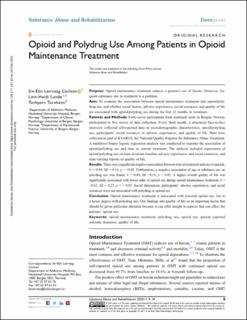| dc.description.abstract | Purpose: Opioid maintenance treatment reduces a person’s use of heroin. However, frequent substance use in treatment is a problem.
Aim: To examine the association between opioid maintenance treatment and opioid/polydrug use, and whether social factors, adverse experiences, social resources, and quality of life are associated with opioid/polydrug use during the first 12 months in treatment.
Patients and Methods: Forty-seven participants from treatment units in Bergen, Norway participated in five waves of data collection. Every third month, a structured face-to-face interview collected self-reported data on sociodemographic characteristics, opioid/polydrug use, participants’ social resources or adverse experiences, and quality of life. Data were collected as part of KVARUS, the National Quality Register for Substance Abuse Treatment. A multilevel binary logistic regression analysis was conducted to examine the association of opioid/polydrug use and time in current treatment. The analysis included regressions of opioid/polydrug use on time-invariant baseline adverse experiences and social resources, and time-varying reports of quality of life.
Results: There was a significant negative association between time in treatment and use of opioids, b =− 0.89, SE = 0.19, p = < 0.01. Furthermore, a negative association of age at substance use on polydrug use was found, b =− 0.40, SE =0.19, p = 0.03. A higher overall quality of life was significantly associated with lower odds of opioid use during opioid maintenance treatment, b = − 0.62, SE = 0.23, p = < 0.01. Social dimensions, participants’ adverse experiences, and social resources were not associated with polydrug or opioid use.
Conclusion: Opioid maintenance treatment is associated with lowered opioid use, but to a lesser degree with polydrug use. Our findings add quality of life as an important factor that should be given particular attention because it can offer insight to aspects that can affect the patients’ opioid use. | en_US |

